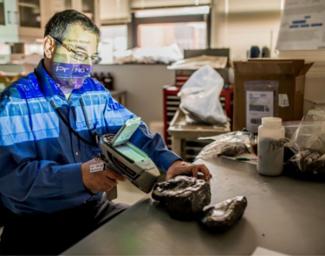Coal powered the industries that created and transported products used by millions all over the world before other fuel options became more prevalent. By working on ways to extract rare earth elements (REEs) from coal and its by-products, NETL researchers are unlocking innovations that could once again make one of America’s most abundant natural resources part of the products people use every day.
REEs are 17 elements found in the Earth’s crust that occur in low concentrations. Because of their unique chemical properties, REEs are essential components of technologies spanning a range of applications, including electronics, computer and communication systems, transportation, health care, and national defense.
Their unusual properties help make the best, strongest, and lightest magnets in the world that are used in products from ear buds to electric motors that power car windows and rearview mirrors. They also enhance light emissions making them integral in fluorescent lighting, computer screens, smartphones, and other every day products. In addition, REEs are important in making nearly every technology used in defense systems that protect the country.
Traditionally, China was the source of 97 percent of the world’s supply of REEs. But, it is growing its own demand for REEs as it creates finished products. Studies by the Massachusetts Institute of Technology indicate that supplies of REEs could fall behind global demand resulting in price instabilities and negative effects on development of new technologies.
When China announced a 40 percent reduction in exports of REEs in 2010, it sparked interest in determining whether U.S. coal resources and coal by-product waste streams from coal cleaning operations and power plants (known as post-combustion materials) could be a source for REEs. That’s when NETL experts began an initial investigative effort to explore the concept of extracting REEs from coal and coal by-products.
Based on early results, DOE-NETL initiated the REE Program in 2014 to address the feasibility of separating and extracting REEs from coal and coal by-products including fly ash, coal refuse, and acid mine drainage. The Program consists of three core technology areas:
- Enabling Technologies that include identification, sampling and analytical characterization of coal-based resources containing REEs; development of techno-economic models for systems analysis; and development of field and REE separation process sensors.
- Separations Technologies that include technology transfer for the use of currently available commercial separation systems developed for alternate applications to separation of coal-based REE-containing materials; development of new/novel, advanced, transformational separation concepts.
- Process System Development Technologies that include design, construction and operation of bench- and pilot-scale systems, generating rare earth concentrate product.
NETL’s overarching goals are to develop separation technologies that can be economically deployed, enabling domestic supplies of REEs, and to reduce environmental impact during REE production from coal-based resources. NETL’s current goals are to validate by 2020, the technical and economic feasibility of prototype systems to produce high purity salable REEs.
NETL has partnered with other researchers from the University of Kentucky, West Virginia University, University of North Dakota, University of Wyoming, and Duke University, as well as the industrial sector to develop REE recovery technologies at both bench-scale and pilot-scale. In addition, five contracts are being conducted to determine domestic REE concentrations in the Illinois Coal Basin, Northern Appalachian Coal Basin in Pennsylvania and West Virginia, Central Appalachian Coal Basin in West Virginia, and the Raton Basin in Colorado and New Mexico.
NETL is also working with West Virginia University to study the feasibility of extracting REEs from solid residues left over after treatment of acid mine drainage.
According to NETL’s Mary Anne Alvin, REE Technology Manager “As the current REE Program grows, we anticipate that the REE research portfolio will expand from not only research conducted in-house and with our current external partners, but also to research involvement at other national laboratories and additional small business innovation efforts.”
Alvin said the NETL REE research to date has yielded solid progress.
“Within the first six months under a project known as ‘Opportunities to Develop High Performance, Economically Viable, and Environmentally Benign Technologies to Recover Rare Earth Elements from Domestic Coal and Coal Byproducts,’external researchers achieved separation and generation of greater than 2 percent by weight REEs from coal-based materials,” she said. “In addition, more than 90 percent REE recovery has been demonstrated from acid mine drainage materials.”
NETL’s in-house research efforts have already resulted in four patent applications including one for a fiber optic sensor that detects parts-per-million REE levels in fluids. She added that techno-economic analysis models are also being developed by NETL, to assess the viability of the REE separations processes for product marketability.
The NETL work could result in an environmentally sound and promising future for coal and coal-based resources where none existed domestically before.




